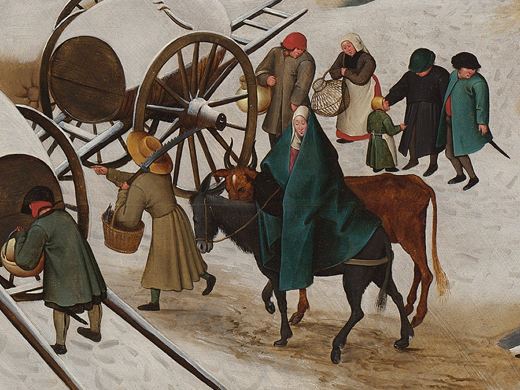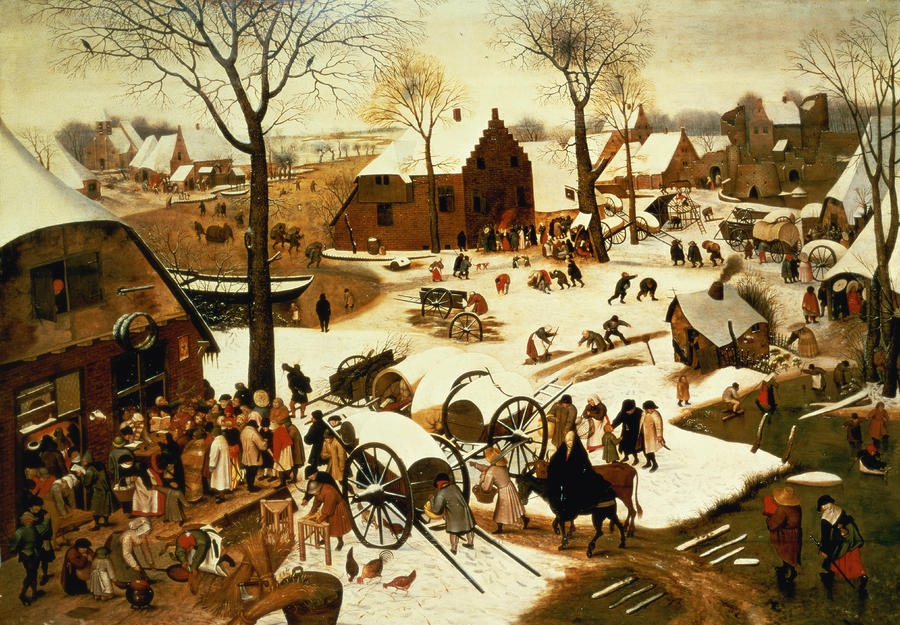In the modern era, the all too human tends to be repressed. But back then, in 1566 it was a time of ingrained, seemingly genetic aggression, envy, hatred and wanton destruction. Perhaps not that dissimilar after all. Bruegel’s Census in Bethlehem works on a number of levels since he juxtaposes themes of messianism and plays on the temporal themes to posit an idea that draws semblances of the sorry state of ancient Israel with his late sixteenth-century life in Flanders and the Netherlands where the people are to be counted and quantified for purposes of financial extraction and religion by extension is a pretext to box in the individual rather than open spiritual pathways. The quantification of faith. Bruegel injects a slightly satiric hint to that of other paintings dealing with “the poetics of counting” such as Massy’s paintings.

Read More:http://www.whdfas.org.uk/ ---Pieter Breugel the Elder, The Census at Bethlehem, 1566 Musées Royaux des Beaux-Arts, Brussels, oil on oak, 116 x 164 cm ---
This is before the nightmarish anti-paradise of modern madness which Goya staked out,but which had previously been represented by Bosch who was no foreigner to pathological depths. Bruegel was just more subtle. The tyranny of modernism was yet to arrive with all its symptoms; but the nature of man, and his pathology to dominate and suck dry what he could followed the same narrative as today. In Census in Bethlehem, the context also bore out some chilling realities. The destitute and poor were dying from cold and want of food, the crops were dead and lots of plant life and trees were sick and perishing. A catastrophe….
…Pieter Bruegel’s Census At Bethlehem grips with its account of a painting that is much more than a simple nativity scene. In fact, of course, its not a nativity scene at all. Bruegel has focussed on the busy moments before the holy couple are settled in the stable – the arrival for the census at their place of birth of a milling crowd of the poor and hungry – ordinary men, women and children bundled up against the cold….

Read More: http://www.flanderstoday.eu/content/welcome-bruegelland ---....Meanwhile his atmospheric snowy landscapes are represented by “Winter Landscape with Skaters and Bird Trap” (1565) and “The Census at Bethlehem” (1566), which brings the Nativity to a small Flemish village in the depths of winter. Mary and Joseph arriving in the foreground seem lost in the flurry of activity going on around them, from the census itself to the slaughtering of pigs and people skating on the frozen river.---
…For this is 16th-century Flanders, under Spanish rule. By the door where the crowd are registering is a plaque bearing the double-headed eagle, symbol of the Hapsburg emperor, Philip II. The men and women at the counter are laying down coins: the Netherlands paid half the tax revenues of the entire Hapsburg empire and four times as much as the Spanish themselves. He painted the picture in 1566, a time of rebellion against both Spanish rule and the Catholic church. A consciousness of Spanish tyranny and slaughter is found in other paintings and drawings by Bruegel, particularly Massacre of the Innocents. In the year that this was painted, Philip said he would rather sacrifice 100,000 people than tolerate heresy in the Netherlands and sent the Duke of Alba to supress rebellion….
…This is a profoundly democratic painting. Bruegel portrays Mary and Joseph as no larger than the other figures in the painting, nor are they placed centre stage: they are people amongst the crowd. It is a secular portrayal – a reflection of the new ideas about individual and society emerging at the dawn of the Renaissance. Paintings would now contain worldly details, artists would be acute observers of animals, plants, landscapes, and – in the new genre of portraiture – people.
In the centre of the painting are two large wooden O’s made by the wheels of some hay wagons. For Bruegel and his viewers, the circle was a symbol of eternity and represented the continuing cycle of life in death and birth. It is a magnificent painting, depicting a world filled with suffering and displacement, but which has redemption at its heart. Read More:http://gerryco23.wordpress.com/2009/12/24/census-at-bethlehem-by-pieter-bruegel/








 COMMENTS
COMMENTS



